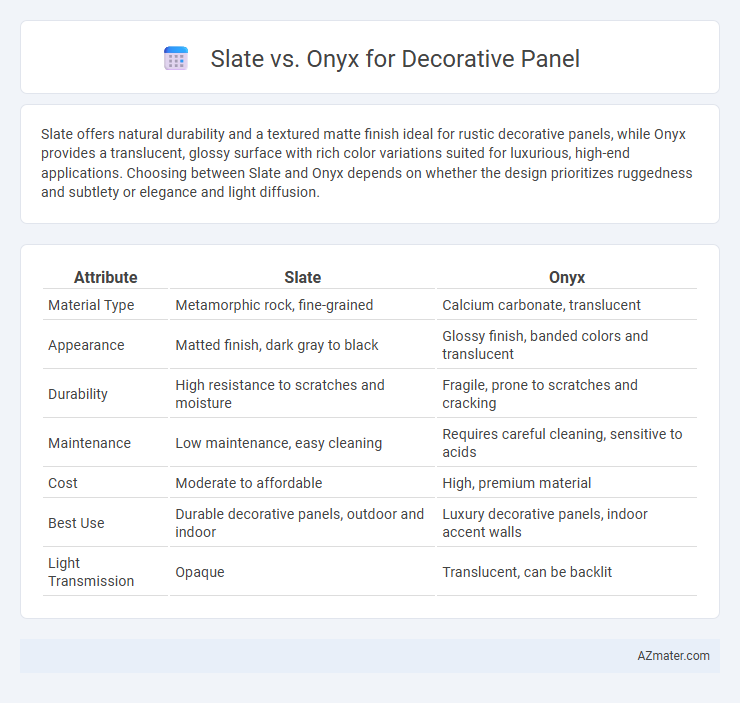Slate offers natural durability and a textured matte finish ideal for rustic decorative panels, while Onyx provides a translucent, glossy surface with rich color variations suited for luxurious, high-end applications. Choosing between Slate and Onyx depends on whether the design prioritizes ruggedness and subtlety or elegance and light diffusion.
Table of Comparison
| Attribute | Slate | Onyx |
|---|---|---|
| Material Type | Metamorphic rock, fine-grained | Calcium carbonate, translucent |
| Appearance | Matted finish, dark gray to black | Glossy finish, banded colors and translucent |
| Durability | High resistance to scratches and moisture | Fragile, prone to scratches and cracking |
| Maintenance | Low maintenance, easy cleaning | Requires careful cleaning, sensitive to acids |
| Cost | Moderate to affordable | High, premium material |
| Best Use | Durable decorative panels, outdoor and indoor | Luxury decorative panels, indoor accent walls |
| Light Transmission | Opaque | Translucent, can be backlit |
Introduction: Slate vs Onyx for Decorative Panels
Slate offers a durable, natural stone texture with muted grays and rich earth tones ideal for rustic or industrial decorative panels. Onyx provides a translucent, luxurious aesthetic with vibrant colors and unique veining patterns, often used in backlit panel applications for striking visual impact. Choosing between slate and onyx depends on the desired ambiance, durability needs, and lighting effects in decorative panel installations.
Material Overview: Characteristics of Slate and Onyx
Slate offers a dense, fine-grained texture with exceptional durability and natural resistance to heat and moisture, making it ideal for long-lasting decorative panels. Onyx features a translucent, crystalline structure renowned for its vibrant, multi-tonal color variations and the ability to be backlit for stunning illumination effects. Both materials provide unique aesthetic appeal, with slate emphasizing rugged, earthy elegance and onyx delivering luxurious, luminous beauty.
Aesthetic Appeal: Color and Pattern Variations
Slate offers a natural, earthy aesthetic with its deep gray to black tones and subtle, organic patterns that enhance rustic and contemporary spaces. Onyx provides a striking visual impact through its translucent properties and vibrant color variations, including rich ambers, greens, and whites, creating dramatic and luxurious decorative panels. Both materials allow for unique, high-end design applications, with slate emphasizing understated elegance and onyx delivering bold, luminous artistry.
Durability and Longevity Comparison
Slate offers exceptional durability with high resistance to scratches, stains, and weathering, making it ideal for long-lasting decorative panels in both indoor and outdoor applications. Onyx, while visually striking with its translucent quality and unique veining, is softer and more prone to scratching and chipping, which may reduce its longevity in high-traffic or exposed environments. The inherent toughness of slate ensures superior lifespan and minimal maintenance compared to onyx, which requires more careful handling to preserve its aesthetic appeal over time.
Maintenance and Care Requirements
Slate decorative panels require minimal maintenance, needing only occasional cleaning with a damp cloth to prevent dust buildup and preserve their natural texture. Onyx panels, being more delicate and susceptible to scratches and stains, demand careful handling and regular sealing to maintain their glossy surface and prevent discoloration. Both materials benefit from avoiding harsh chemicals and abrasive cleaners to extend their lifespan and aesthetic appeal.
Cost Differences and Budget Considerations
Slate decorative panels typically involve higher upfront costs due to natural stone extraction and processing expenses, making them less budget-friendly for large-scale projects. Onyx panels, while generally more expensive per square foot, offer unique translucency and aesthetic value that can justify their premium price in high-end interior designs. Budget considerations should factor in installation complexity, as Onyx often requires specialized handling, potentially increasing total project costs compared to slate.
Installation Process: Slate vs Onyx Panels
Slate panels typically require a more labor-intensive installation process due to their heavier weight and natural stone texture, demanding specialized tools and skilled labor for secure mounting and alignment. Onyx panels, being lighter and translucent, allow easier handling and faster installation, often utilizing backlighting elements for aesthetic enhancements without additional structural support. Both materials necessitate surface preparation and careful sealing to ensure longevity, but Onyx's delicate nature calls for extra caution to prevent cracking during installation.
Application Areas: Ideal Spaces for Each Material
Slate decorative panels excel in kitchens, bathrooms, and outdoor areas due to their natural durability, moisture resistance, and rustic aesthetic. Onyx panels are preferred in luxury interiors such as hotel lobbies, upscale bars, and feature walls, providing a translucent glow and elegant, high-end appeal under backlighting. Both materials suit varied applications, but slate thrives in high-traffic, moisture-prone environments while onyx is ideal for statement design elements in controlled indoor spaces.
Environmental Impact and Sustainability
Slate offers a natural, durable option for decorative panels with minimal processing, resulting in a lower carbon footprint and excellent recyclability, making it a sustainable choice. Onyx, while visually striking due to its translucency and unique veining, often requires intensive quarrying and energy-consuming treatments, increasing its environmental impact. Selecting slate panels can significantly reduce environmental degradation and promote sustainability in architectural applications.
Conclusion: Choosing the Right Decorative Panel Material
Slate offers natural durability and a unique textured appearance ideal for rustic and outdoor settings, while Onyx provides a luxurious, translucent finish perfect for modern interiors with backlighting features. Consider slate for its robust resistance to weather and wear, making it suitable for high-traffic areas, whereas Onyx excels in aesthetic appeal and light diffusion but requires delicate handling. Selecting the right decorative panel material depends on balancing environmental conditions, design goals, and maintenance preferences to achieve both functionality and visual impact.

Infographic: Slate vs Onyx for Decorative Panel
 azmater.com
azmater.com